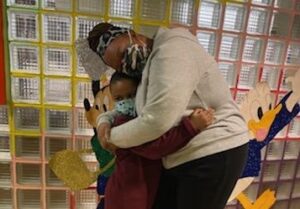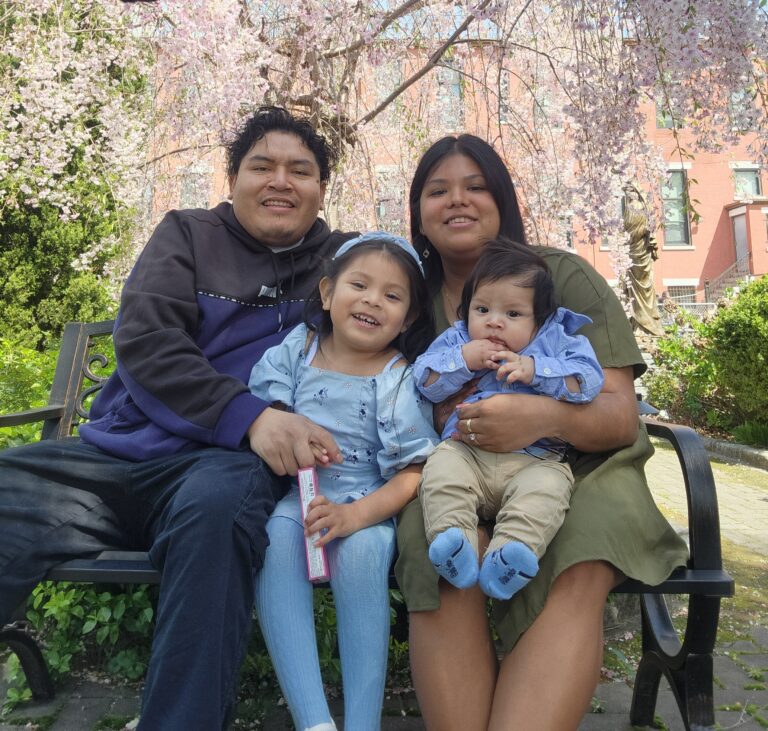By Traci Donnelly, Chief Executive Officer

Trina (with son Terrell) was one of many women who faced impossible choices when the COVID-19 pandemic exposed how few supports women have.
Incremental change is no longer an option for those who seek to improve the lives of marginalized populations — and if we’re to be honest with ourselves, it never was. After a year of profound loss and social upheaval, the inequalities and deep, historic injustices we’ve been content to just live with have never stood out so dramatically.
This can be painful, but it is also hopeful: It is in this new climate of painful change that opportunities for progress have emerged. Against this backdrop, we mark International Women’s Day 2021 with the theme #ChooseToChallenge. Organizations and corporations should take the opportunity to challenge ourselves to dig deeper, listen deeper, elevate diverse voices, and take a serious and ongoing look at how to break free of longstanding inequitable systems, reimagine new ones, and build them. We must make serious and ongoing commitments to be anti-racist, radically inclusive, and truly equitable. We have a long way to go, and the work will never end, but we have unique opportunities to move the needle.
Signs that time’s up on incremental change were blinding in 2020. For years, we have been making incremental progress toward racial equity, but the brutal murders of Ahmaud Arbery, George Floyd, Breonna Taylor, and so many others made clear that it had never been enough. The inequity we saw in schoolchildren from under-served neighborhoods told to attend school virtually without laptops or Wi-Fi access laid bare the fact that three decades of promises to close the digital divide had been woefully inadequate. And the way the COVID-19 pandemic affected women at every point on the income spectrum revealed how little society values women’s work, and how few supports we have. The statistics bear out what we are seeing with our own eyes: Women accounted for a full 100 percent of jobs lost in December, losing 156,000 jobs, while men gained 16,000 jobs, according to the National Women’s Law Center. In fact, the gender lines of pandemic job loss have been so starkly drawn that it’s been dubbed the “she-cession.”
As always, low-income women, particularly BIPOC women, have been disproportionately affected. Women like Trina, a single mom and health home aide who couldn’t work from home, but also couldn’t leave her six-year-old son alone when schools closed.
Here at The Child Center of NY, we are taking a long hard look at our role and where we must do more to challenge a system that perpetuates inequities. This International Women’s Day, we #ChooseToChallenge ourselves to make clear commitments to center our clients and communities and engage in a new way of doing business: one that redefines our approach to the “provider-client” relationship and, through action, places trust in families (a majority of them headed by women) as the experts on what they need to achieve their goals, with our job being to act as investors, advocates, and partners.
This change was inspired by what we learned from our clients and communities this past year. Many of our clients, like Trina, work in the service industry, as restaurant workers, house cleaners, home aides for elderly and children, and in other service-related jobs. They were the first to be let go at the beginning of the pandemic, left suddenly without any income, when they were already at or below the poverty line. For many of them, there was no safety net whatsoever. Our staff, deeply embedded and trusted in the communities they serve, listened to what our clients told us they needed to get through this profoundly challenging time. We quickly learned the best support strategy was directly investing in them with cash. We gave away over $725,000 — no strings attached — trusting 1,300 families to determine their own financial priorities. We discovered families used funds more creatively than we imagined and that even small sums made a big impact.
From these lessons learned, we are redesigning existing programs where we can and developing new ones where we must. For example, we are building on the cash assistance program with a new innovative cash transfer program, aimed at supporting families to lift themselves out of poverty by giving them the financial freedom to pursue their goals. Called CashWorks, the program challenges traditional top-down anti-poverty approaches by investing unrestricted cash stipends to families living below the poverty line with the idea being that once the necessities — child care, food and clothing, medicine, etc. — are taken care of, families can actually focus on their strengths and goals and take steps to achieve them, whether by investing in technology and reliable Wi-Fi, pursuing an educational degree, or vocational trainings (e.g., Commercial Driver License, food handling certification) — it’s their choice. To assist them in tracking their progress, the program will provide a customized digital workspace called the Mutuality Platform so families can make data-informed decisions. One of the most exciting components is the program’s community-based “pay it forward” structure: Families will take the journey together with other members of their community and pass the baton to a new cohort when their time in the program concludes. We have engaged two partners in the program, Root Change and the Community Independence Initiative (CII), both leaders in the Alternative Approaches movement to ending global poverty.
CashWorks and other programs like it foster gender parity not only by supporting individual women, but also through the underlying premise: that talent and drive are equally distributed among populations, but resources and opportunities are not. More than ever, I’m convinced that our overarching goal here at The Child Center is to even out this equation in the communities we serve. We will be undertaking a sweeping audit of all programs, as well as internal policies affecting our staff — who are overwhelmingly women, and particularly women of color — to assess whether they advance or hinder this goal.
We don’t pretend to have all the answers, and there surely will be missteps along the way, but one thing we all can challenge ourselves to be is bold.






